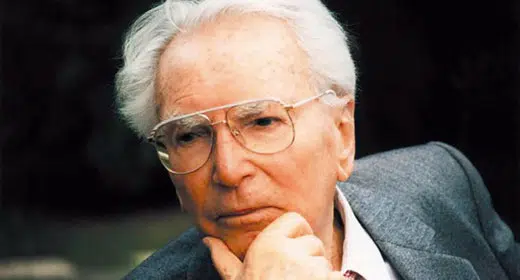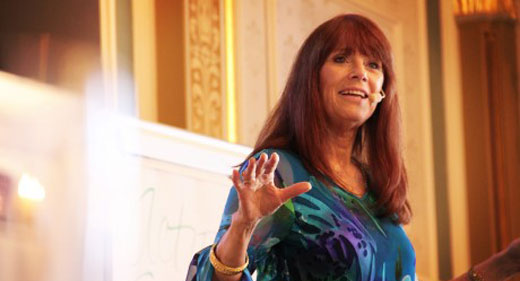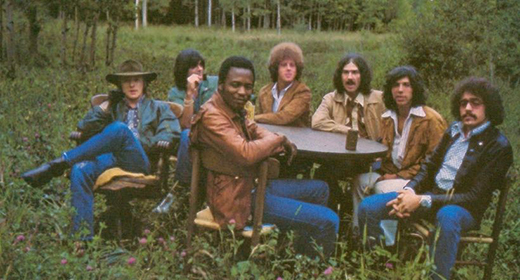by Richard Simon: Being larger than life was something Virginia Satir knew about from her earliest days.

She grew up bigger and smarter and more keenly aware than any of the kids her age in the Wisconsin farm community where she was raised. By the time she was three, she had learned to read. By the time she was 11, she had reached her adult height of nearly six feet. Even though her schooling was interrupted by long stretches of illness, she started college after only seven-and-a-half years of formal education. As she described it, “I never had to worry about being like everybody else. I always knew I wasn’t.”
Growing up a big, awkward, sickly child, Satir drew from her experience of being an outsider a finely tuned sensitivity to other people’s fears that they were different or strange. Maybe it was that sensitivity as much as anything else that accounted for her ability to connect with something very deep in the people she helped. Satir had a way of making people feel that she appreciated, as perhaps had ever before, just what set them apart from anyone else running around the planet, and that their different-ness was neither a defect nor a burden, but a treasure of inestimable value.
From the very beginning of her career, starting out as a school teacher in the late 1930s, Satir was drawn to people who were haunted by their sense of being different. At night, she would visit the homes of the students in her class to find out what was getting in their way, what triggered the feelings of low self-esteem that weighed so heavily on some of them. In the process, she discovered the power of the family and its role in constraining a child’s development. Later, when she became a social worker and grew increasingly interested in figuring out the subtle dynamics of family life, it was the outcasts—the schizophrenics, the institutionalized, the unwed mothers, the lost souls of the world—who drew her deepest sympathies.
By the late ’50s, Satir was already receiving widespread recognition as one of the foremost practitioners of a new approach to change called family therapy. In 1964, with the publication of Conjoint Family Therapy, her practical, down-to-earth introduction to the art of this new therapy, she gained a worldwide reputation. Constantly on the road from that time until the very end of her life, demonstrating her dramatic techniques and deeply empathic way of working, she became a kind of living legend as family therapy’s most celebrated recruiter and good-will ambassador.
As her reputation spread, she became perhaps the most imitated therapist of her time. Posters of her favorite sayings decorated the offices of agency workers around the country. Practitioners everywhere tried to copy the intimate, folksy, comforting style they saw Satir use with such skill and such moving effect. Thinking they were following in her footsteps, they urged their puzzled clients to throw themselves into symbolic postures and hug each other and give voice to feelings many never dreamed they could utter to another living soul.
But while many therapists were able to imitate Satir’s mannerisms and the basic elements of her techniques, far fewer were able to get anything like the results she achieved. They didn’t realize that what Satir did worked because it fit her so completely. At the core of her approach was her unshakeable conviction about people’s potential for growth and the respectful role helpers needed to assume in the process of change. These deeply rooted principles formed the basis of how she saw her task as a therapist.
In 1985 I published the following interview with Virginia Satir in Common Boundary, a journal concerned with the links between psychotherapy and spirituality. It provides an unusually crystallized discussion of the beliefs that lay at the heart of Satir’s views about the art of therapy. In this memorial issue exploring her contribution to psychotherapy, it seems only fair that she be allowed to have her own say in the matter.
Q: I have had the opportunity to watch your work several times and what stands out is how you create a therapeutic world in which ordinary resistance does not seem to exist. How do you understand your ability to get people, whom other therapists might consider unbudgeable, to make changes in their lives?
SATIR: Some therapists think people come into therapy not wanting to be changed; I don’t think that’s true. They don’t think they can change. Going into some new, unfamiliar place is a scary thing. When I first begin to work with someone, I am not interested in changing them. I am interested in finding their rhythms, being able to join with them, and helping them go into those scary places. Resistance is mainly the fear of going somewhere you have not been.
I had an experience once that taught me a lot about how to lead people into scary places. I was in Europe, staying with some friends. I wanted to descend into a cave but was very frightened. My friend said, “I’ll carry the light. If you give me your hand and allow me to lead the way, then maybe we can go down together.” Now look at the decision I had to make. I had to choose to allow him to lead me. That was something I was willing to do because I was interested in getting down there. Unless he had been willing to give me his hand and unless his hand felt trustworthy, I would not have gone.
When people come to see me, I don’t ask them if they want to change. I just assume they do. I don’t tell them what’s wrong with them or what they ought to do. I just offer them my hand, literally and metaphorically. If I can convey to the person that I am trustworthy, then we can move and go to the scary places.
Q: Do you ever come across people, who, for whatever reason, will not take your hand?
SATIR: Very seldom. When I am completely harmonious with myself, it is like one light reaching out to another. At the outset, it is not a question of “I will help you.” It is simply a question of life reaching out to life. All life talks to life when it is in a harmonious state. If my ego is involved or if I need them to get well, then it is a different story. This is one of the secrets of what I do, if there is a secret.
Q: So i f you are in pretty good shape with yourself, the first step with a client is never a problem.
SATIR: Let me elaborate. If you and I meet at a revolving door which only has room for one, we have to decide who will go first. In going first, I have to go on the faith that my energies translate in a positive way to the other person and that they follow. Now once we get outside, I say, “Where do you want to go?” I no longer set the direction. I need to find out where they want to go.
Being asked that question shocks many people. They cannot believe that anybody really wants to know the direction in which they want to go. They keep rationalizing, justifying, questioning, and so on. Finally, they decide, “Yeah, I believe she really does want to go in the direction I want to go.” Then we take the steps. We can walk five steps and see how it is; whether it really fits. If not, then we see what else we want to do. The big problem in whether or not somebody continues to take your hand is whether or not your hand is sending dominating messages. As a therapist, I am a companion. I try to help people tune into their own wisdom. Of course, all this doesn’t fit much of a psychothera-peutic theory.
Q: You clearly prefer not to discuss therapy in a technical language. Whenever I have heard you speak, I have been impressed with the spiritual appeal you make to people. You speak the language of hope.
SATIR : I think one of the most important things I do for people is give them some kind of hope for themselves. But it is not only in relation to me that they get their hope, it is in relation to seeing more clearly what they have.
Q: What about your own spiritual beliefs? Many people think of you as a kind of apostle of the religion of human potential. Does it go beyond that for you?
SATIR : I try to help people see what is right in front of their faces. What is obvious to me is that we did not create ourselves. Egg and sperm do that job. All we do is activate the opportunity for those two things to get together. Realizing that puts you in a place where you know that life is something inside of you. You did not create it. Once you understand that, you are in a spiritual realm. That does not mean “religion” in the usual sense. The physicists know about this. More and more I am seeing that the physicists and the good theologians know what the basic life force is all about. It is something you can call “spirit,” “soul,” or whatever you want. In any case, it is there and the only thing that really changes people is when they get in contact with their life force. That is the essence of self-worth.
Q: So how do you think these ideas about the “life force” are influencing the field of psychotherapy?
SATIR : Oh yes, especially in the current interest in the right brain and how it works. You see, a long time ago, people knew there was access to a person, though not through the usual channels. At one time, it was called “mesmerism,” then “hypnotism.” That is where Freud started out. All those words really refer to accessing the right brain. Thanks to Buckminster Fuller and other people, we now know that the right brain is a residual for all the information that there is in life. Today, hypnotherapists, parapsychologists, psychics, some physicists, and those who are studying death are coming together in the knowledge that there are levels of knowing beyond our linear understanding.
One therapist who obviously used these ideas was Milton Erickson. He accessed the right brain all the time, which helped people to get to some new places. What was called “psychic phenomena” yesterday is the same as what many people call “hypnosis” today. It is not that there is something over here called “hypnotism,” something over there called “biofeedback,” and something called “out-of-body experiences.” All these are manifestations of the same thing.
Q: But would you ever refer to what you do in therapy as “hypnotic?”
SATIR : No, but I know that it is. What am I doing? I am accessing the right brain when I ask somebody how they feel and when I help them to connect with parts of their body. I am engaging in what the hypnotists would call a “trance” or an altered state.
Q: Even though you would not, I have heard Richard Bandler and John Grinder talk about your work as a form of very powerful hypnosis. Supposedly you are one of the models for Neurolinguistic Programming (NLP). What do you think of NLP as a translation of what you do?
SATIR: Let me put it this way. If I look at an orange, I have many ways of describing it. I can describe it in terms of its uses, its color, its form. I can also just eat the orange. With that analogy, what I think Richard and John did is make a left-brain analysis of my work related to psycho-linguistics. It was another level of looking at something. When I first met them, I was very excited about what they were doing. But I would not want to learn NLP, if you want to know the truth. I am not sure I could learn it. The part that bothers me about NLP is where practitioners take it as the end-all and be-all and forget the heart and soul of people involved. For me, anything that leaves out the heart and soul of an individual has got to reinforce what I consider the “scourge” in our society, which is that we touch the surface; we never touch the core.
Q: You seem to have a curious position in the family therapy field today. While various surveys of practitioners cite you as one of the most influential forces on their work, you don’t seem involved in the field any longer.
SATIR: Some time ago, I decided to stop going to any of the big professional meetings. The competitiveness and the bullfights got to be too much for me. Listening to people talk, I began to feel as if it was not professional to care about people.
Q: Would you talk about how your experience with your own children has affected your work?
SATIR : I have two adopted children who are now 40 and 41 years old. I adopted them when they were 10 and 11. They are natural sisters who came from a perfectly terrible environment. They actually presented themselves to me and asked if I could be their mother.
Q: These were youngsters with whom you were working?
SATIR : Yes. One of them was in an institution for delinquent girls. I thought, “Why not?” The oldest one said, “You know, I’ve never had any mother but you, really.” So, we made it legal. Judging from the difficulties of their past, I knew that there would be great difficulties ahead. There were. However, we survived them and learned from them.
When my children first came, they regarded food as the chief vehicle of love. In those days, S500 a month for groceries — which is what I spent— was a whole lot. Even though there was all this food in the house, I would find food cached in many places. I just kept buying the food. It took about three months before they figured out that the food was not going to disappear. I understood that they could not directly relate on the nurturing level, they had to go through it by stages.
The other thing about my children was the fact that they were so much for the underdog. I mean literally. I remember coming home one day and finding 26 dogs and five cats in the house. I will never forget that sight. One of my daughters had gone around the neighborhood and picked up all the homeless dogs. Twenty-six dogs and five cats on a rainy day in the house— you can imagine what that was like!
It was sort of hard to live through, but I finally got all that straightened out. These illustrations are some of what we went through at first, but I knew down deep that these kids had the potential and that they needed help for them to realize it.
That is one of the things that brought me to work with families. You see, I started my work with families whose members no one else wanted to work with. I knew that being able to change and grow had to do with how people felt about themselves. Of course back then, I had not developed the word “self-esteem.” That was a fancy word I learned later.
Q: There’s no secret you are probably the prototype of the nurturing therapist. How is that different from being the mother of two daughters?
SATIR : I think the difference comes in the fact that you are one step removed when you are doing therapy. When you are in it yourself, you have to work harder with yourself to keep your head straight, your heart straight, and your emotions straight. When things came up in my own family, I really benefited from my own awareness. If I would get angry with one of the kids for some reason or another, I did not go at them as I had seen other people do. Instead I said, “Okay Virginia, what’s going on with you?” I would not take all of the responsibility myself, but I was straight. I would say, “You know I’m very angry and this is what it’s about.” If you’re a plumber, you use your plumbing abilities to fix your own faucets. Why not use your insights and awarenesses to be whoever you are?
Q: What did your children think about your career, your traveling, and your being a public person?
SATIR : I will give you a little example. There is a very strong bond between my children and myself. It has several dimensions. One of them is that they know that I have to do something in life that they cannot share. They also respect what I do. So we get together when we can. There was a big party for me about five years ago in Los Angeles; several hundred people were there from all over the world, among them my youngest daughter. People were talking about what I meant to them. My daughter got up and said, “I want to tell you how I feel about my mother. I think that some of you have had more of my mother than I have.” Then she looked directly at me and said, “I want you to know, mother, that I am sometimes so jealous that other people have what I didn’t. That’s one side of it.” But then she added, “I also want to tell you how deeply I feel about the importance of what you’re doing. Not only what you are doing for others, but what you have done for me.”
I felt that it was a beautiful statement of the kind of marriage that she had to make with what I do. I don’t see my grandchildren as often as I would like, but that is part of the price I pay for how I live my life.
Richard Simon, Ph.D., is the editor of the Family Therapy Networker.









































